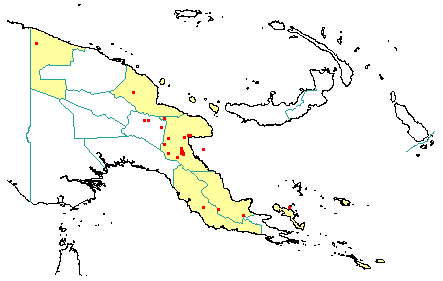
in PNGplants database
PNGTreesKey – Flindersia pimenteliana F.Muell. |
Barry Conn (NSW) & Kipiro Damas (LAE).
Guide to trees of Papua New Guinea
Copyright held by the authors, National Herbarium of New South Wales, and Papua New Guinea National Herbarium
Fragmenta Phytographiae Australiae Vol. 9: 132 (1875)
Other Literature: D.J. Boland et al., Forest Trees of Australia 620-621 (1984) Fig. 621 (page).
Family: Rutaceae
Dicotyledon
Timber Group: Minor hardwood
Field Characters: Large canopy tree (up to 40 m high) or Small sub-canopy tree; Bole cylindrical (up to c. 100 cm diam.); straight (mostly bole up to 20 m long); buttresses buttresses absent; spines spines absent; aerial roots aerial roots absent; stilt roots stilt roots absent; Bark grey or brown, slightly rough, pustular or slightly cracked, lenticels elongated vertically; Subrhytidome (under-bark) sometimes green or dark red; less than 25 mm thick, (6.0-) 8.0-14.0; bark blaze consisting of one layer; strongly aromatic or faintly to non-aromatic; pleasant (fruity); outer blaze white, yellow (pale (straw-coloured), red, or pink, with stripes (white), fibrous; inner blaze pink, red, white, or yellow (pale (straw-coloured), with stripes (white), fibrous; bark exudate (sap) present, colourless, not readily flowing (spotty), colour not changing on exposure to air, not sticky; terminal buds not enclosed by leaves.
Indumentum: Complex hairs absent; stinging hairs absent; mature twig indumentum (hairs) absent.
Leaves: Leaves spaced along branches, opposite (in pairs, opposite one another on the branchlet) (to subopposite), compound (a leaf made up from two or more leaflets); petiole present, not winged, attached to base of leaf blade, not swollen; leaves pinnate (unbranched with more than three leaflets); petiolule not swollen; rachis present, absent, absent; leaves with a terminal leaflet (the number of leaflets odd - imparipinnate), broadest below middle, 8.0-34.0 cm, 2.0-5.0 cm, leaflets opposite, symmetric (to slightly asymmetric), terminal developing leaflet buds straight; venation pinnate, secondary veins open, not prominent, but visible, intramarginal veins absent; leaves lower surface pale green or yellowish green, upper surface dark green, indumentum (hairs) absent; absent or present; domatia absent; stipules absent.
Flowers: Inflorescence terminal, flowers on a branched axis, cones absent; flowers bisexual, stalked, flowers with many planes of symmetry, 2.5-4.0 mm long, diameter small (up to10 mm diam.) (c. 3 mm diam.); perianth present, with distinct sepals and petals whorls, inner perianth red (dark towards base) or white (on inner surface); 5, some or partly joined (shortly at base) or free; stamens 5, present, free of each other, free of the perianth; ovary superior, carpels joined (when more than one), locules 10 (2 per carpel); styles solitary, 1.
Fruits: Infrutescence arranged on branched axis, fruit 50.0-120.0 mm long, 40.0-60.0 mm diam., brown, spiny (with blunt spines), non-fleshy, simple, dehiscent, capsule; seeds 30 (c.), much more than 10 mm long (40-60 mm long), winged (at both ends), narrow (longer than wide), seed 1-10 mm diam. (c. 10 mm diam.).
Distribution: West Sepik, Madang, Morobe, Central, Northern & Papuan Islands.
 | Botanical records in PNGplants database |